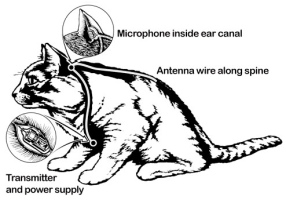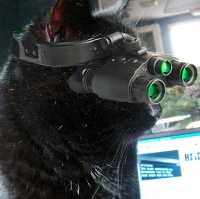- About Us
- Columns
- Letters
- Cartoons
- The Udder Limits
- Archives
- Ezy Reading Archive
- 2024 Cud Archives
- 2023 Cud Archives
- 2022 Cud Archives
- 2021 Cud Archives
- 2020 Cud Archives
- 2015-2019
- 2010-2014
- 2004-2009
 |
(August 2013) The Cat Who Came In From The Cold |
"Good morning, Mister Phelps. Your mission, if you decide to accept it, is to read the following without either shaking your head in absolute wonder or collapsing to the floor in hysterics. As always, should you or any of your IM force be caught or killed, the Secretary will disavow any knowledge of your actions. Good luck, Jim. This tape will self-destruct in five seconds..."

I mean, come on: it's bad enough that fun and weird history writers like myself can't just relax when people bring up ghosts or UFOs, ridiculous, conspiracy theories, or astrology without collapsing into hysterical giggles, gasping for air trying to get out, "You think that's strange? Wait until you hear this--" without that same bizarre universe throwing out yet another example of how truly, honestly, and totally surreal the planet really can be.
Okay, to be honest, the 1960s were a total benchmark for the odd ... especially in the world of already-far-too-odd world of espionage. It was, after all, when the CIA was drawing up plans to make Fidel Castro's beard fall out with hormone-tainted cigars or blow him up with booby-trapped seashells as they were dosing unsuspecting US citizens with acid – while on the other side of the world their opposite numbers were killing people with poisoned umbrellas and (by plan or their own stupidity) convincing the US that psychic remote viewing actually worked.
It should come as no surprise then that somewhere in this fuming cauldron of bizarre, someone, somewhere in Langley – the Directorate of Science And Technology to be precise – began to dream of a totally new information gathering technique.
What put this technique into the surreal, if not utterly insane, column were the recruits for this project. To be fair, animals had been used quite successfully by covert, as well as overt, operations for hundreds of years: horses have been used in combat since human beings first climbed on the back of one, birds – carrier pigeons to be precise – have been used for a very long time to get information from remote locations back to base, dogs have been trained for both combat as well as stealth assassinations, and -- adding to the crazy of the crazy the 1960s – trained dolphins were first imagined as Flipper with a suicide pill.

But as anyone who has ever had even a passing familiarity with them would know, the best you can hope for with a cat is a very simple list of commands... always directed at the so-called owner of the animal and never the other way round.
But that’s just what Project Acoustic Kitty was: to create an electronically wired cat. Before you ask, this wasn't just a think-tank bit of Strangelove-ial whimsy. For five or so years the CIA worked on the project – spending some 20 million dollars in the process.
First, there were some technical details – such as developing a battery, receiver, transmitter, and antenna that could be not just carried by but actually implanted in the poor kitty. But this was nothing compared with the (yes, you may laugh) training of the cat: according to experts and still-quite-censored documents, the men on Acoustic Kitty had quite a bit of difficulty in getting the cat to ... well, not be so much of a cat.
Skipping over the additional Frankenstein-ish details – including putting the antenna in the poor cat's tail – the men of Acoustic Kitty finally claimed they were ready for a test of this groundbreaking new informational gathering technology. Their higher-ups gave them the green light in the form of a very special potential target: nothing less than the Soviet Embassy in Washington DC.

It's so easy to imagine: a crisp East Coast morning, a pair of Acoustic Kitty Operatives – no doubt codenamed Boots and Mister Frisky – sitting in a van across from the extremely sensitive sovereign soil of the USSR, everything riding on their five years of hard work in the form of multi-million dollar cybernetic pussy.
Finally, they decided the time was right: the cat was released and – with undoubtedly hypothesized certainty – our feline agent of democracy glanced back over its furry shoulder at its handlers with a look of determination that the mission would succeed at any cost. The cat then headed across the road- its destiny as a free cat, as well as the future of Acoustic Kitty, in its humble paws...
...but then was almost immediately hit and killed by a cab.
Okay, that's bad – not to mention tragic for the poor cat – but what's worse is that Acoustic Kitty actually continued on nonetheless: a second feline agent was recruited and, once more, it went through who-knows-how many hours of cyberization and training. Luckily – especially for this second poor cat – someone up the ladder glanced back down at the Directorate of Science And Technology and decided, rightfully so, that they were all completely and utterly bananas and subsequently pulled the plug on the project.

The CIA tried its best to put a smile on this litter box of a mess by claiming in documents – which only came to light in 2001 as part of the Freedom Of Information Act – that the Kitty's staff were “models for scientific pioneers." The reason? Because they'd managed to prove through their multi-million dollar endeavor that while the usefulness of cats in espionage was seriously in doubt, they had shown that cats could be "trained to move short distances."
This second kitty, thankfully, wasn't ordered to use his cyanide-laced catnip: reports say that the feline agent had its implants removed and lived a good, long life afterwards.
Curiously, no one seems to be able to shed any light on the last remaining Acoustic Kitty puzzle: why, after being brought back in from the cold, this decommissioned cat mysteriously made several cryptic communications – in the form of dead-mouse-drops -- with known KGB operatives...
M.Christian has published more than 300 published short stories, is the editor of over 20 anthologies - including The Burning Pen, Guilty Pleasures, The Mammoth Book of Future Cops and The Mammoth Book of Tales of the Road (with Maxim Jakubowksi) and Confessions, Garden of Perverse, and Amazons (with Sage Vivant) - and is the author of the collections Dirty Words, Speaking Parts, The Bachelor Machine, Licks & Promises, Filthy, Love Without Gun Control, Rude Mechanicals, and Coming Together: M.Christian; and the novels Running Dry, The Very Bloody Marys, Me2, Brushes, and Painted Doll.
